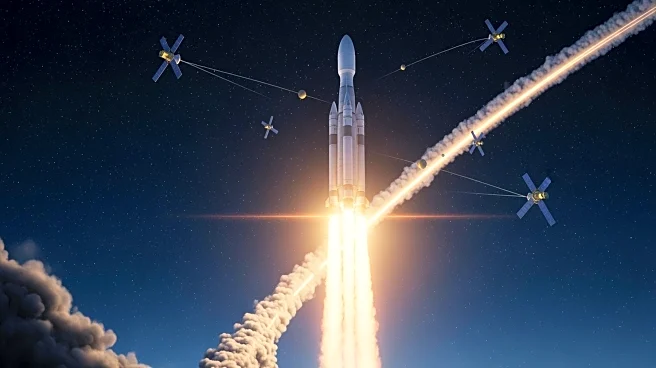What's Happening?
On October 19, SpaceX successfully launched a Falcon 9 rocket from Cape Canaveral Space Force Station, deploying 28 Starlink satellites into low Earth orbit. This mission, known as Starlink 10-17, marked
a significant milestone as it was the 31st flight of the Falcon 9 booster designated 1067. The booster set a new record for reuse, demonstrating SpaceX's continued advancements in rocket technology. The launch took place at 1:39 p.m. from Launch Complex 40, and the booster successfully landed on the drone ship A Shortfall of Gravitas in the Atlantic Ocean. This achievement underscores SpaceX's commitment to reducing the cost of space travel through the reuse of rocket components.
Why It's Important?
The successful launch and recovery of the Falcon 9 booster highlight SpaceX's leadership in the commercial space industry. By setting a new record for booster reuse, SpaceX continues to push the boundaries of what is possible in space travel, potentially lowering costs and increasing the frequency of launches. This development is crucial for the expansion of the Starlink satellite network, which aims to provide global internet coverage. The implications for industries reliant on satellite communications are significant, as improved access and reduced costs could drive innovation and connectivity in remote areas. Additionally, SpaceX's achievements may influence public policy and investment in space exploration and technology.
What's Next?
SpaceX is expected to continue its aggressive launch schedule, further expanding the Starlink network and enhancing global internet coverage. The company's focus on reusability and cost reduction may lead to increased competition in the space industry, prompting other companies to innovate and improve their technologies. Stakeholders, including government agencies and private enterprises, will likely monitor SpaceX's progress closely, as it could impact future collaborations and investments in space exploration. The success of this mission may also encourage further development of reusable rocket technology, potentially leading to more sustainable and cost-effective space travel.
Beyond the Headlines
The record-setting reuse of the Falcon 9 booster raises important questions about the long-term sustainability and environmental impact of increased space activity. As the frequency of launches grows, concerns about space debris and its management become more pressing. Additionally, the expansion of the Starlink network has sparked debates about the regulation of satellite constellations and their impact on astronomical observations. These issues highlight the need for international cooperation and regulation to ensure that the benefits of space exploration are balanced with the protection of the space environment.












